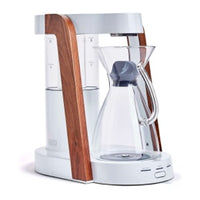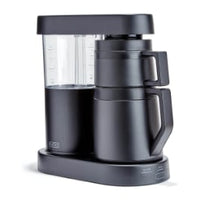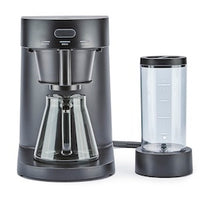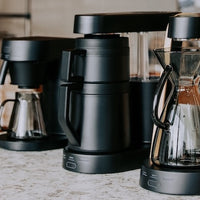The Hidden Problem With Brewing Lighter Roasts
Key Takeaways
-
Lighter roasts require different brewing adjustments compared to darker roasts
-
Under-extraction is a common issue due to lighter roasts’ denser structure
-
Grind size, water temperature, and brew time are critical for unlocking flavor
-
Poor adjustments can lead to sour, underdeveloped coffee even with great beans
-
Precision brewing equipment helps ensure lighter roasts reach their full potential
Lighter roasted coffee is prized for its complexity — think bright fruit notes, floral aromatics, and layered acidity. Yet many coffee drinkers find their lighter roasts taste sour, weak, or unbalanced. The problem isn’t the beans themselves, but the brewing approach.
While you can brew dark and medium roasts with a relatively forgiving technique, lighter roasts demand precision. Their density, chemistry, and flavor profile make them less soluble, which means they need different brewing variables to shine.
Why Lighter Roasts Are Trickier to Brew
Roast level changes the physical and chemical makeup of coffee beans. Lighter roasts are roasted for less time, so:
-
The beans retain more of their original density and moisture
-
The cell walls are less brittle than in darker roasts
-
Flavor compounds are less caramelized and more delicate
This combination makes them harder to extract. Water has to work harder to penetrate the dense structure and dissolve flavor compounds.
The Under-Extraction Trap
The most common brewing mistake with lighter roasts is under-extraction. This happens when water fails to pull enough soluble compounds from the grounds. The result?
-
Sour or grassy flavors
-
Thin body
-
Astringent finish
Under-extraction is often caused by using the same grind size, temperature, and brew time you’d use for darker roasts — settings that aren’t optimized for the denser structure of light roasts.
Grind Size Adjustments
To improve extraction for lighter roasts, you’ll often need a finer grind. This increases the surface area exposed to water, allowing more flavor compounds to dissolve.
Tips for dialing in grind size:
-
Start slightly finer than your usual setting for medium roasts
-
Avoid going too fine — this can lead to over-extraction or clogging in pour-over filters
-
Use a quality burr grinder for consistency
Consistency in grind size ensures even extraction, avoiding pockets of over- or under-extracted grounds in the same brew.
Water Temperature Matters More
Water temperature plays an even bigger role with lighter roasts than with darker ones. The denser cell structure requires more energy to release flavor compounds.
-
Ideal range: 200–205°F (93–96°C)
-
Too low (<200°F): Risk of sourness from under-extraction
-
Too high (>205°F): Risk of bitterness, though lighter roasts are more forgiving at higher temps than dark roasts
If your brewing device allows, monitor and maintain stable water temperature throughout the brew.
Brew Time and Contact Time
Because lighter roasts need more effort to extract, slightly longer brew times can help. However, the increase should be gradual:
-
For pour-over: Extend by 15–30 seconds
-
For immersion brewing: Add 20–40 seconds to your steep time
-
For espresso: Increase shot time by 2–5 seconds, adjusting grind as needed
Longer contact time allows more flavor compounds to dissolve without tipping into over-extraction.
Bloom and Degassing
Lighter roasts tend to be fresher in specialty coffee circles, meaning they often have more trapped CO₂. If not released properly during brewing, excess gas can cause uneven extraction.
Solution:
-
Use a longer bloom phase (30–45 seconds instead of 20)
-
Pour enough water to fully saturate the grounds during bloom
This helps water contact be more consistent for the rest of the brew.
Choosing the Right Brew Method
Some brewing methods handle lighter roasts better than others:
-
Pour-over (V60, Kalita Wave): Excellent for highlighting complexity, but demands precision
-
AeroPress: Good for experimenting with finer grinds and longer contact times
-
French press: Can bring out body, but may mute delicate high notes if steeped too long
Regardless of method, the key is adjusting technique for the roast level.
Freshness Still Matters
Even though lighter roasts hold their flavor compounds longer than dark roasts, they can still go stale. Stale lighter roasts lose their vibrancy and complexity, making brewing adjustments less effective.
Storage tips:
-
Keep beans in an airtight, opaque container
-
Store in a cool, dry place
-
Avoid refrigeration unless in a sealed vacuum bag
The Role of Water Quality
Since lighter roasts often emphasize subtle flavor notes, poor water quality becomes more noticeable. Hard water can mute acidity, while overly soft water can make coffee taste flat.
A balanced mineral content (around 150 ppm total dissolved solids) is ideal for bringing out both brightness and sweetness in lighter roasts.
The Ratio Coffee Advantage
A coffee machine from Ratio Coffee provides the temperature stability, even saturation, and consistency needed to brew lighter roasts well. When combined with fine-tuned grind size, proper bloom, and adjusted brew time, these machines help reveal the complex flavor profile lighter roasts are known for.
Bringing It All Together
Brewing lighter roasts isn’t more complicated — it’s more intentional. You can’t treat them the same way as darker roasts and expect great results. The key is understanding that roast level changes how coffee responds to water, and adjusting variables like grind, temperature, and brew time accordingly.
With the right approach, lighter roasts can produce cups bursting with clarity, complexity, and nuance — qualities that are easily lost with a one-size-fits-all brewing method.
Frequently Asked Questions
Why does my lighter roast always taste sour?
It’s likely under-extracted. Try a finer grind, higher water temperature, or slightly longer brew time.
Do lighter roasts have more caffeine?
Slightly, but the difference is small. Roast level has less impact on caffeine content than many believe.
Can I brew lighter roasts in an espresso machine?
Yes, but they often require a finer grind and longer shot time to avoid sourness.
Should I use the same coffee-to-water ratio for light and dark roasts?
You can start with the same ratio, but you may need slight adjustments depending on flavor balance.
Is a longer bloom always necessary for light roasts?
Not always, but in most cases, it improves extraction by releasing more trapped CO₂ before full brewing begins.
 Ratio Eight S2
Ratio Eight S2
 Ratio Eight Original
Ratio Eight Original
 Ratio Six
Ratio Six
 Ratio Four
Ratio Four
 Compare Machines
Compare Machines






